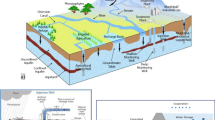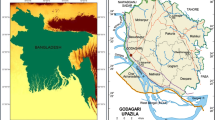Abstract
Water demand will increase and augmenting freshwater resources from the rainwater and flash flood will decrease the gap between supply and demand. Flash floods, which is considered as one of the worst weather-related natural disasters are highly unpredictable following brief spells of heavy rain. The eastern desert and the Sinai Peninsula are subjected to flash floods, where floods from the mountains of the Red Sea and Sinai are causing heavy damage to man-made features. The central focus of this chapter was to achieve a sustainable water resources management in the Sinai Peninsula. The objective of the current chapter is to mitigate and utilize the floods water as a new supply for water harvesting in Sinai. Applying water harvesting of the flash flood will reduce the flood risk at the outlet. In addition, it could be used for recharging the groundwater aquifers, which are the basis for sustainable development in Sinai. Furthermore, Bedouins usually move from place to place searching for fresh grazing for their animals and water for their families. These locations sometimes are hazardous areas as flash floods occur there. This chapter helps to make developed sustainable planning for the Bedouins, as hazard areas were defined. Established places to harvest and store the flooded water would allow the Bedouins to resettle the area. The total amounts of rainfall affecting the different drainage systems in Sinai is of the order of 2000 million m3/year, and the most of possible runoff water is about 150 million m3/year rainfall was roughly determined at some sites; for El-Arish region is about 1000 million m3/year (100 million m3/year runoff), 75 million m3/year (4 million m3/year runoff) for El-Gerafi region, 240 million m3/year (10 million m3/year runoff) for the Gulf of Suez region, 150 million m3/year for Bitter Lakes region, 300 million m3/year for south El-Bardawil region, and 100–600 million m3/year for the Gulf of Aqaba.
Access this chapter
Tax calculation will be finalised at checkout
Purchases are for personal use only
Similar content being viewed by others
References
Abd-El Monsef, H. (2010). Selecting the best locations for New Dams in Wadi El-Arish Basin using remote sensing and geographic information system. In Sinai International Conference for Geology & Development Saint Katherine, South Sinai, Egypt.
Abdelkarim, A., Gaber, A. F. D., Youssef, A. M., & Pradhan, B. (2019). Flood Hazard assessment of the Urban area of Tabuk City, Kingdom of Saudi Arabia by integrating spatial-based hydrologic and hydrodynamic modeling. Sensors, 19, 1024.
Abu Al-Izz, M. S. (1971). Landforms of Egypt (281 p). Dar-A1-Maaref, Cairo, Egypt.
Abuzied, S. M., & Mansour, B. M. H. (2018). Geospatial hazard modeling for the delineation of flash flood-prone zones in Wadi Dahab basin, Egypt. Journal of Hydroinformatics, 21, 180–206.
Dames and Moore. (1983). Sinai development study, Final report.
Dames and Moore. (1985). Sinai development study—Phase I, Final Report, Water Supplies and Costs. Volume V-Report Submitted to the Advisory Committee for Reconstruction, Minstry of Development, Cairo.
EGSMA. (1981). Geological Map of Egypt, Scale 1,2000000. Egyptian Geological Survey and Mining Authority.
El-Shamy, I. (1992). Towards the water management in Sinai Peninsula. In Proceedings of the 3rd Conference on Geology and Sinai Development (pp. 63–70), Ismailia.
El Shamy, I. (1995). The control of flood. Egyptian Geographic Society of Egypt (in Arabic).
Ghodeif, K., & Gorski, J. (2001). Protection of fresh ground water in El-Qaa Quaternary aquifer, Sinai, Egypt. New approaches characterizing flow. Seiler & Wonhnlich, Swets & Zeitliger Lisse. ISBN: 902651-848-X.
Jalilov, S.-M., Kefi, M., Kumar, P., Masago, Y., & Mishra, B. K. (2018). Sustainable Urban water management: Application for integrated assessment in Southeast Asia. Sustainability, 10.
Masoud, A. A. (2011). Runoff modeling of the wadi systems for estimating flash flood and groundwater recharge potential in Southern Sinai, Egypt. Arabian Journal of Geosciences, 4, 785–801.
Mohamed, S. A., & El-Raey, M. E. (2019). Vulnerability assessment for flash floods using GIS spatial modeling and remotely sensed data in El-Arish City, North Sinai. Natural Hazards year: Egypt.
Prinz, D., & Singh, A. (2000). Technological potential for improvements of water harvesting. Study for the World Commission on Dams, Cape Town, South Africa. (Report: Dams and Development).
Ramli, I. (1982). Water Resources in the Sinai Peninsula and its basic and regional development plans in the next 50 years (1982–2032). Desert Research Institute, Ministry of Agriculture, Al-Matareya, Cairo.
Said, R. (1962). The geology of Egypt. Amesterdam, New York: El-Sevier Publishing Company.
Schanze, J. (2006). Flood risk management—A basic framework. In J. Schanze, E. Zeman, & J. Marsalek (Eds.), Flood risk management: Hazards, vulnerability and mitigation measures. NATO science series IV (pp. 1–20). Berlin: Springer.
Shadeed, S., & Lange, J. (2010). Rainwater harvesting to alleviate water scarcity in dry conditions: A case study in Faria Catchment, Palestin. Water Science and Engineering, 3, 132–143.
Shata, A. (1992). Watershed management, development of potential water resources and desertification control in Sinai (pp. 273–280). Ismailia, Egypt: Geology and Sinai Development.
Sumi, M., Saber, M., & Kantoush, S. A. (2013). Japan-Egypt hydro network: Science and technology collaborative research for flash flood management. Journal of Disaster Research, 8, 177–178.
Tooth, S. (2000). Process, form and change in dryland rivers: A review of recent research. Earth-Science Reviews, 51, 67–107.
WRRI. (2010). Flash floods in Egypt protection and management, final report. National Water Research Center. Ministry of Water Resources & Irrigation Egypt LIFE06 TCY/ET/000232.
Author information
Authors and Affiliations
Corresponding author
Editor information
Editors and Affiliations
Rights and permissions
Copyright information
© 2020 Springer Nature Switzerland AG
About this chapter
Cite this chapter
Omran, ES.E. (2020). Egypt’s Sinai Desert Cries: Utilization of Flash Flood for a Sustainable Water Management. In: Negm, A. (eds) Flash Floods in Egypt. Advances in Science, Technology & Innovation. Springer, Cham. https://doi.org/10.1007/978-3-030-29635-3_12
Download citation
DOI: https://doi.org/10.1007/978-3-030-29635-3_12
Published:
Publisher Name: Springer, Cham
Print ISBN: 978-3-030-29634-6
Online ISBN: 978-3-030-29635-3
eBook Packages: Earth and Environmental ScienceEarth and Environmental Science (R0)




